|
Introduction
The overwhelming demographic and social changes that
have changed the six-nation Gulf Cooperation Council
(GCC) region (Bahrain, Kuwait, Oman, Qatar, Saudi Arabia
and the United Arab Emirates) will continue in the coming
decade. The GCC population, total 45 million people
in 2011, is less than 1% of the global population. It
has one of the fastest-growing populations in the world
however. By 2020 this population is forecast to increase
by one-third, to 53 million people. The vast majority
54% will be under 25 years of age. This is estimated
to change to about 36% by
2050. The swift growth and the relative youth of the
population present serious challenges as well as major
opportunities (1).
The GCC is one of the wealthier
regions, in terms of GDP/capita (at just under $32,000),
well above the MENA Ex. GCC, and in line with North
America and Europe. It is a distinctive region due to
its unique hydrocarbon reserves compared to a relatively
small, national population. Growth in the six economies,
in terms of spending and GDP/Capita as well as welfare,
heavily relies on oil revenue to attract private investors
and to provide extensive public services and subsidies
to nationals. With not enough diversification in the
economy, the GCC countries’ government spending
will continue to cause a
drain on fiscal accounts.
Based on unchanged policies
and historic trend, the International Monetary Fund
(IMF) forecast a 2% annual growth in real GDP for the
rest of the decade.
In addition, IMF also predicted
an annual increase in population of 3.5%. The imbalance
in growth rates requires GCC governments to look closer
at their policies to better match macroeconomics priorities
and objectives (5).
GCC citizens feel unaccountable
for their welfare; the current education systems do
not provide them with world-class, competitive skills,
government employment and unemployment benefits remove
the incentive for specialization and dynamic job seeking
and the lack of skilled national manpower, and consequent
dependence on expatriate labor will remain. Reforms
are needed to aid countries to diversify their economies
to head away from an unrestrained fiscal drain.
GCC Demographic Structure
Size and Growth
The GCC has a low population, when compared with other
regions, totaling nearly 45 million people in 2011.
The most populated country is Saudi Arabia with 28 million
(65% of the total), followed by nearly 8 million in
the UAE. The International Monetary Fund estimates a
compounded growth rate (CAGR) of 2.41% in the next 5
years, increasing the population further to 49 million
in 2016.
The growth rate is substantially
lower than the CAGR throughout 2004-2008 of 5.9% (1).
By 2025, the GCC is predicted
to have a total population of 57 million, to grow by
about 14 million more by 2050. As of 2011, the lowest
median age in the GCC is 24 years in Oman and the highest
is 31 years in Qatar. The average age in the entire
GCC region is 27 yrs with over 20% below the age of
15.
The Pyramids
The young population will predominate in the GCC over
the coming decade, which is different from the ageing
populations of the US and western Europe. The proportion
of the population under 15 years is substantial. The
fertility rate in the GCC has been declining as there
is more prominent consciousness of family planning.
Except for Oman, all other GCC countries’ fertility
rates have diminished by more than 50% (2). This could
likewise be associated to the increased average cost
for basic items and increased education prospects for
women. As the age of marriage increases, this diminishing
pattern in birth rates is anticipated to persist. In
addition, GCC pyramids have a skewed lump in the male
section, particularly working age, which is because
of the high number of male expatriates in the countries
(3).
While the more youthful age
group (15-24) comprises the main part of the Arab population,
development rates among nations vary enormously and
are falling over time, showing that this section will
encounter declining swelling rates going forward. Between
1995-2010 Yemen had the most noteworthy rate among Arab
nations, with the young population multiplying in a
fast way, however this is predicted to swell by under
40% throughout the following 15 years.
Saudi Arabia saw its young population
swell by 66% in the course of the most recent 15 years,
yet this rate is predicted to tumble to only 15% through
2025. It is fascinating to take note of that the adolescent
population 15-24 will decrease in Iran, Algeria, Morocco,
Tunisia, Lebanon, and Turkey throughout the following
15 years, showing pointedly declining birth rates and
additionally expanded newborn infant death rates.
The enormous size of the youthful
population, which has expanded access to education,
the global media and new advancements, proposes that
social states of mind and standards may change quickly.
The current pattern of more
women entering the work force is probably going to proceed,
buttressed by expanded interest in educating women for
employment, an adjustment in social demeanors and the
production of good examples for another age of working
women. Organizations will confront strains to adjust
to this pattern, yet won’t really utilize similar
models found in the West.
The population will stay very
young over the forecast period, in divergence to the
ageing populations of the US and western Europe. The
percentage of the population under 5 years of age will
drop from 29% in 2008 to 24% in 2020, but will remain
sizeable. The large size of the young population, which
has increasing access to education, the international
media and new technologies, indicates that social attitudes
and norms may change fast.
Population trends
Demographic trends normally change gradually and population
totals usually are considered as being among the easier
economic indicators to forecast. However, population
growth in the GCC is profoundly driven by immigration
trends, with expatriates making up 42% of the region’s
population in 2009. This leads to population totals
being less foreseeable. There are three possible scenarios.
The GCC’s population would
flourish from an estimated 39.6 million in 2008 to 53.4
million in 2020– a 33% increase over 12 years.
This level of population growth will need marked investment
in infrastructure and services, including power, water,
transport, housing, healthcare and education. This will
place pressure on government budgets. Much of the GCC’s
current spending goes on wages, subsidies, healthcare
and education. The need for these services will increase
parallel to population growth.
Urbanization of the population
is already there, and this will endure to remain the
situation, with added pressure on urban infrastructure
and housing. Where space permits, some governments will
endeavor to develop new policies to decrease the stress
on current cities, such as the “economic cities”
in Saudi Arabia.
By 2020 only the Africa region
will have a younger population profile than the Middle
East . The US and Europe will progressively seek to
attract younger migrants from overseas to help decrease
their old/young dependency ratio, and, in particular,
to help fund pensions. These countries are also expected
to make rising efforts to entice foreign students to
their universities as their own populations age.
The relative youth of the population
will constrain the healthcare burden on public spending,
but young GCC nationals will also hurt from what are
sometimes termed diseases of prosperity, such as diabetes
or smoking-related diseases. There is a challenge to
provide adequate healthcare needs of the region over
the next 10-20 years. Most governments in the region
have already made important preparations to meet the
challenge. Currently some 75% of healthcare spending
in the GCC is funded by the public sector. Obesity and
cardiovascular diseases, are expected to account for
a significantly larger proportion of total healthcare
costs in the future.
It is predicted that spending
on healthcare as a proportion of GDP will rise from
current levels of less than 5%, but will not reach the
level spent in Europe (typically around 8%) or the US
( 5%) by 2020.
The large size of the young
population, and its rising access to education, the
international media and new technologies, indicates
that social attitudes and norms will change fast. The
new generation of young people in the GCC will be highly
educated, and will thus have high expectations of high-status
future employment.
They will be progressively technologically
literate. Many will be prosperous and well-travelled,
and educated overseas, giving them a high awareness
of different lifestyles, and cultures. Even those who
are not educated abroad will be more likely to speak
foreign languages and to use the Internet to communicate
with
young people from other countries and cultures.
The
Expatriate
Most of the of the GCC population comprises expatriates.
In light of 2010 Information, Credit Suisse stated Qatar
as having 86.5% expatriates, the highest percentage
of international migrants in the world, despite the
fact that these tend to have a transient quality and
relocate in and out on a regular basis.
This
is trailed by 70% and 68.8% in Kuwait and the UAE, respectively.
The GCC region as a whole has
an average of 53.43% of expatriates matched to an average
of 9.5% in the MENA region. Qatar has the biggest immigration
rate in the world with 40.62 of 1,000 people entering
the country being expatriates. None of the GCC countries
have a negative net immigration rate which demonstrates
that there is always a higher rate of expatriates entering
than leaving.
Table 1: Expatriate Population
2010
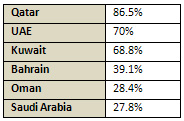
The high inflow of expatriates is reflected in the
GCC labor force. The positions filled by expatriates
extend from low-paying, low-skilled construction jobs
to exceedingly professional and dedicated jobs. Closely,
4.5 million nationals are potentially entering the job
market compared to 5 million nationals who were employed
in 2010. IMF predicts that an extra 2 to 3 million nationals
will not be capable of finding jobs (4).
Welfare
GCC countries are famous for their liberal and broad
welfare framework. The government appropriated its oil
incomes for vital motivations to guarantee accessible
fundamental services. Most government services are either
at no cost or at exceptionally subsidized prices such
as electricity, water, gas, healthcare and commodities
such as food. Aside from Oman where local companies
are taxed, taxes in the other GCC countries mainly consist
of foreign corporation income taxes.
This welfare system is stressed
and frustrated by the Elderly Support Ratio, which calculates
the degree to which the youth population is able to
support the aging and retired. Currently, on a global
scale, there are 9 working age persons supporting one
non-working age person while in the GCC the ratio is
significantly higher, with the UAE and Qatar having
the highest at nearly 80 people in support of one senior
citizen.
At present, on a worldwide scale,
there are 9 working age people supporting one non-working
age individual while in the GCC the proportion is altogether
higher, with the UAE and Qatar having the most noteworthy
at almost 80 individuals in help of one senior resident.
Be that as it may, a stark inversion is normal in only
40 years, when this proportion is anticipated that would
drop to the low single digits over the GCC. This basically
implies that by 2050, Kuwait, for instance, will have
only 3 working age people supporting one senior citizen;
this will constitute a noteworthy strain on resources
for the country.
References
1. GCC Population Forecast to
Reach 50 Million in 2013, Business Intelligence Middle
East, 18 February 2012
2. Arab Human Development Report, United Nations Development
Program, 2010
3. Smaller Old age population and the number of people
in each age group increases as we move down the population
pyramid
4. Meeting the Unemployment Challenge, Masood Ahmed,
19 January 2012
5. Bahrain’s Budget Deficit up 5-fold in 10 Years,
SyndiGate.info, 4 April 2012
6. A Welfare System, Kingdom of Saudi Arabia Ministry
of Foreign Affair
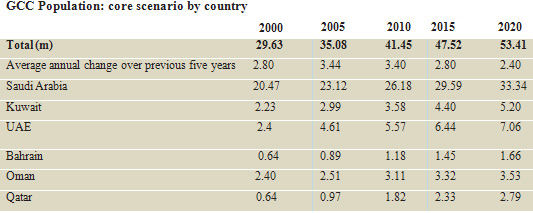
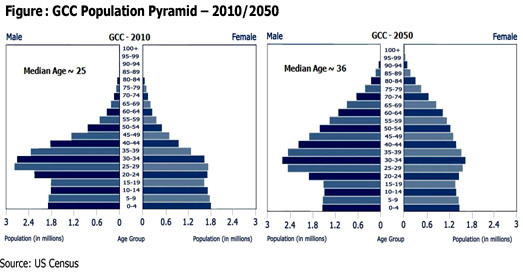
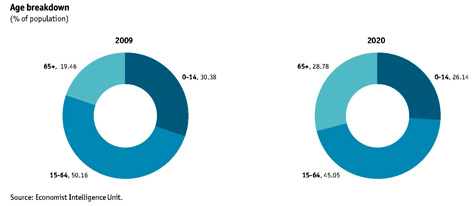
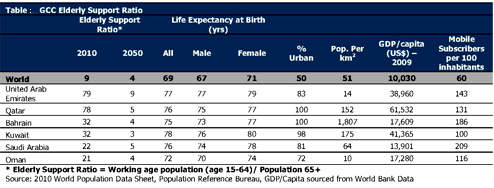
Citation:
Please cite this article as: Abdulrazak Abyad, Demographic
Changes in the GCC Countries: Reflection and Future
Projection. 2018; 15(1):20-24. DOI: 10.5742/MEJAA.2018.93292
|

